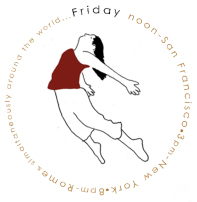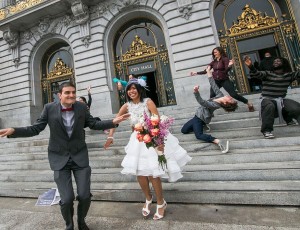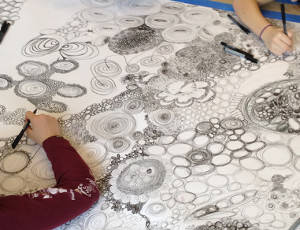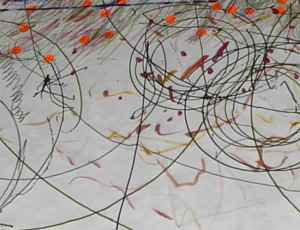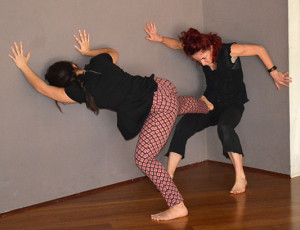For anyone living in Southern California, you can almost pick any day of the year to go outside and enjoy the weather, particularly in San Diego. The city is considered a Navy town by some, a coastal community for others, and arguably, most popularly known as home to the San Diego Chargers, Qualcomm, and the fish taco. As an all-around active, growing, great-weather city that attracts people from all over the country eager to call San Diego their home, you can hop in your car, and drive to the many neighborhoods around the county, from La Mesa and El Cajon in the East County down to Eastlake/Chula Vista in the South Bay, and up to Del Mar and Encinitas in the North County coastal areas. For those who rely on public transportation, you can hop on the Trolley to…er, La Mesa and Downtown, for now. As the city comes out of its financial woes, there is anticipation among many San Diegans for the expansion of the Trolley lines. And for Jean Isaacs, founder of San Diego Dance Theater, and creator of the San Diego Trolley Dances, she’ll be ready to follow the Trolley wherever it may grow in the city, bringing art to the public and changing how people view dance and space in unconventional locations.
This year marks the 15th year the San Diego Trolley Dances have been in production, but it was a lot of hard work and adaptability getting to this point. Inspired by a trip she made to Bern, Switzerland, when Isaacs came back to the U.S. and faced exorbitant theater costs, finding creativity in non-traditional space was all the motivation Isaacs needed to organize the first Trolley Dances, and enough reason to keep developing the event year after year. In our phone interview, Isaacs sounds like a busy woman but effable and friendly as we speak about the event. “[I grew]…tired of dancing on stage… [and with Trolley Dances,], I use what is there,… [and] let the dance create itself.” Using alternative spaces, Isaacs is able to draw inspiration from different sources, such as the architecture, and the lighting. When you are talking about paying $15K for one performance in one theater, being outdoors in sunny San Diego weather in a public space becomes appealing on different levels for an artist. Along with being bothered by expensive theater costs, but driven more by a desire to provide her dancers with a new stage to grow and perform, she turned her eye to the San Diego Metropolitan Transportation System (SDMTS). She established a relationship with the agency, and then a few years later, the head of the marketing and public relations department got involved, and it has been a mutually beneficial relationship ever since. Most riders on the Trolley lines are from working-class neighborhoods, so Isaacs gets to bring art and dance to wider public audience in non-traditional spaces, and the SDMTS Trolley system gets a boost in public awareness and ridership.
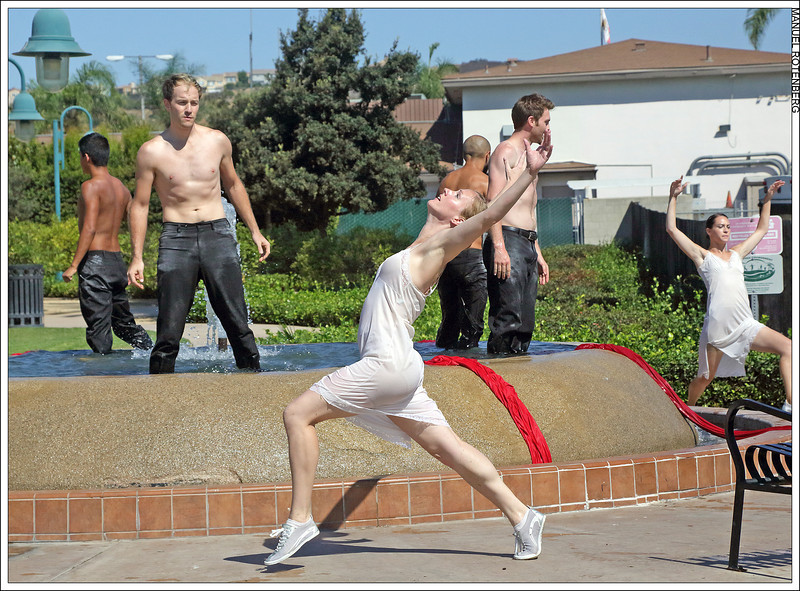
Photo by Manuel Rotenberg.
As the interview continues, Isaacs’ tone becomes more relaxed as I ask her how she thinks the Trolley Dances have influenced the San Diego cultural arts scene.
“… [Trolley Dances] is the mother of public art in San Diego… every year is different….” And each year, these new spaces present choreographers a new challenge as well as different audiences from different communities. In last year’s Trolley Dances, Isaacs recruited new and veteran choreographers to create pieces for each of the trolley stops using young dancers and professionals from the community. The choreographers used fire pits, closed off roads, and trolley stations to convey different themes. Isaacs also choreographed a piece called Tough Guys Wear Pink, illustrating the cold realities of the world of work.
For some in the audience, this will be their first time being exposed to public art such as contemporary dance. Most of the riders on the MTS Trolley come from working-class neighborhoods and backgrounds, so the production touches audiences that will probably never look at the spaces in quite the same way again. And if Anais Nin is right in that “…it is the function of art to renew our perception,” then Isaacs finds this influence a compliment to the work she and her dancers invest in creating a show that is both relevant and beautiful in public space.
As for what the future holds, Isaacs sees the event becoming more thematic. For this year’s production, when I ask her for details, Jean tosses out a few ideas that center around the idea of green energy. No locations have been confirmed yet but she rattles off a few sites she has considered such as the Old Town trolley stop which is in the heart of San Diego, next to picturesque Mission Bay. Or Barrio Logan, a working class neighborhood south of downtown.
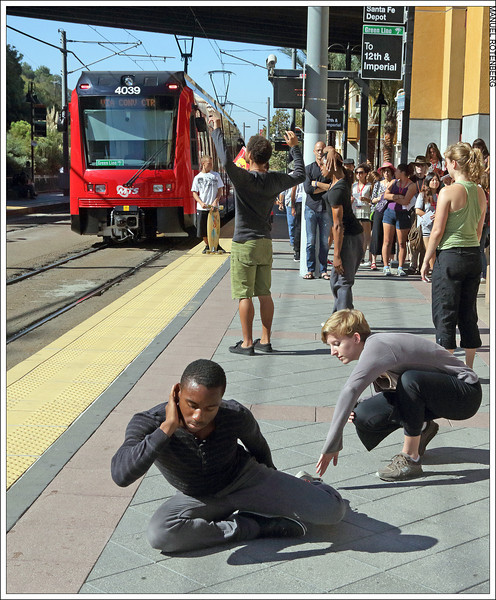
Photo by Manuel Rotenberg.
With the Trolley Dances established in San Diego, other local regions in California have also taken strides to adapt the same model of bringing art to the public in their own cities. Isaacs has franchised the Trolley Dances brand to the cities of Riverside, San Francisco, and Stockton, mentoring and providing support to dancers who believe in the work of Trolley Dances. In the middle of her own frustrations with trying to provide a stage for her dancers, and confined by the limits of traditional theater space, Isaacs found an opportunity to branch out, and saw the possibilities in unconventional venues and public spaces to develop performance art. Now in its 15th year of production, Jean foresees a continued partnership with SDMTS as the Trolley Dances marches on to entertain new audiences, and change the way the public views conventional space. Currently, San Diego is the 6th most populous city in the country, and the transportation agency has big plans to expand the trolley line to serve more communities. If that is case, with Isaacs’ leadership and vision, the Trolley Dances will continue to follow wherever the lines lead, bringing dance to unexpected places, changing our perceptions about what is considered a stage, and exposing dance to new eyes.
For more information about the next scheduled San Diego Trolley Dances, please visit San Diego Dance Theater at http://www.sandiegodancetheater.org/.

 Sign In
Sign In